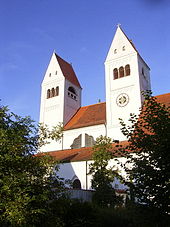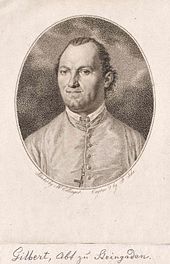Gilbert Michl
Gilbert Michl ( baptized May 27, 1750 in Abensberg ; † October 2, 1828 in Steingaden ), real name Franz Benno Michl , was a Bavarian Premonstratensian , composer and the last abbot of the Steingaden monastery .
Life
Formation and early religious life
In 1764, Franz Benno Michl for the first time as a student of of Jesuit -led Electoral School mentioned in Munich. In 1772 he became a novice in the Steingaden monastery; a year later he made his vows there and chose the name Gilbert as his religious name . In 1774 he was ordained a priest . In the same year he started studying law at the University of Ingolstadt . In 1777 he became a professor of theology .
In Ingolstadt, Gilbert Michl came into contact with the Illuminati secret society founded there in 1776 and joined it. Although he remained lifelong loyal to the basic ideals of the Illuminati, the creation of an unruly and fraternal society through moral education, because of the increasing anti-church orientation of the Illuminati, he resigned at the latest in 1786 and even demanded an oath from his novices that they were not part of the Illuminati.
Administrator and Abbot of Steingaden

At the end of the 18th century, the Steingaden monastery was on the verge of financial ruin. One of the reasons was the immense construction costs for the Wieskirche , which had risen from the originally estimated 39,000 fl to 180,000 fl; in addition, 100,000 florins were added for the baroque transformation of the abbey church. Abbot Augustin Bauer finally saw no other way out than to apply to Elector Karl Theodor to abolish the monastery in 1783 , but the latter refused. When Augustine died a year later, Karl Theodor forbade the election of a new abbot. Gilbert Michl was appointed administrator of the monastery on October 24, 1784 . In the following years Michl was able to reduce the debt burden of the monastery considerably, so that two years later the Secret Council approved the election of a new abbot. On November 26, 1786 Gilbert Michl was elected abbot.
In the following years he managed to further improve the monastery’s financial situation. However, it remained tense, also because the Napoleonic Wars repeatedly led to additional burdens in the form of special taxes, billeting and extortion by soldiers.
Despite the poor financial situation, the monastery could still afford structural investments. For example, under Abbot Gilbert from 1787 to 1790, a 75-meter-long new building for the monastery brewery was built, which was modern for the time and is still preserved today.
Secularization and later work
On February 17, 1802 Gilbert Michl submitted an 83-page report on the reorganization of the Premonstratensian order in Bavaria . The writing comprised proposals for the reform of monastic life as well as for the monastic economy .
However, the proposals came too late to be put into practice. On March 25, 1803, the Steingaden monastery was dissolved as part of the secularization . What was left of the monastery property became state property. The 25 remaining canons were compensated with money and mostly became pastors or teachers. Eleven (according to other sources nine) of them stayed in Steingaden or in the Wies for a few years, including Gilbert Michl. He initially withdrew to the hospice at the Wieskirche and devoted himself to looking after the pilgrims . Overall, the retired abbot worked in Steingaden for another 25 years before he died there on October 2, 1828. According to the inscription on his tombstone, he has made a special contribution to rebuilding the school system.
The Abt-Gilbert-Michl-Straße in Steingaden is named after him.
Musical creation

Virtually all of Gilbert Michl's musical work was lost in the turmoil of secularization, including all of the original manuscripts. Only two compositions can be specifically proven.
On the one hand, there is a symphony in D major, which was listed in an inventory of the Schäftlarn Abbey from 1803, but is now lost.
On the other hand, three historical copies of a Requiem in E flat major, which most likely dates from the period between 1772 and 1775, have been preserved, namely in the Bishop's Central Library in Regensburg, in the Cathedral Library in Freising and in the St. Peter Abbey in Salzburg . The work is composed for four soloists, four-part mixed choir ( SATB ), violins, viola, 2 horns or (in the Dies Irae ) trumpets, timpani and organ.
Discography
Parts of the Requiem are available on vinyl or CD :
- Das Benedictus with Kieth Engen as bass soloist and the Musica Bavarica chamber orchestra under the direction of Alois Kirchberger ( "Early Music from the Pfaffenwinkel " )
- Agnus Dei , Cum Sanctis Tuis and Requiem (Introitus) with the choir of the Herz-Jesu-Kirche Munich under the direction of Josef Schmidhuber ( "Music from Upper Bavarian Monasteries" )
Web links
- Works by and about Gilbert Michl in the catalog of the German National Library
- Gilbert Michl in the Bavarian Musicians' Lexicon Online (BMLO)
- Recording of "Benedictus" from the Requiem on the website of the House of Bavarian History
Individual evidence
- ↑ a b c d e Hans-Josef Bösl: Gilbert Michl (1750-1828), the last abbot of Steingaden - A life between the Enlightenment and secularization in: Sankt Barbara Abensberg - How it was and is , Abensberg 2005, p. 39– 68
- ↑ Historisches Steingaden: On Monastic Paths ( Memento of the original from September 28, 2015 in the Internet Archive ) Info: The archive link was inserted automatically and has not yet been checked. Please check the original and archive link according to the instructions and then remove this notice. (PDF; 4.1 MB)
- ^ A b Premonstratensian succession in Steingaden "a happy coincidence" in: merkur-online of January 9, 2012
- ↑ www.strassenkatalog.de
- ↑ a b c d Hans Stangl: The musician Gilbert Michl from Abensberg in: Sankt Barbara Abensberg - How it was and is , Abensberg 2005, pp. 69–81
Remarks
- ↑ In the literature, September 26th is sometimes found as the date of birth. However, Hans-Josef Bösl was able to use the Abensberg baptismal register to prove that Michl was baptized on May 27th. The confusion is probably due to careless reading of the baptismal register entry.
| personal data | |
|---|---|
| SURNAME | Michl, Gilbert |
| ALTERNATIVE NAMES | Michl, Franz Benno (real name) |
| BRIEF DESCRIPTION | German Premonstratensian and composer, last Abbot of Steingaden |
| DATE OF BIRTH | baptized May 27, 1750 |
| PLACE OF BIRTH | Abensberg |
| DATE OF DEATH | October 2, 1828 |
| Place of death | Steingaden |
